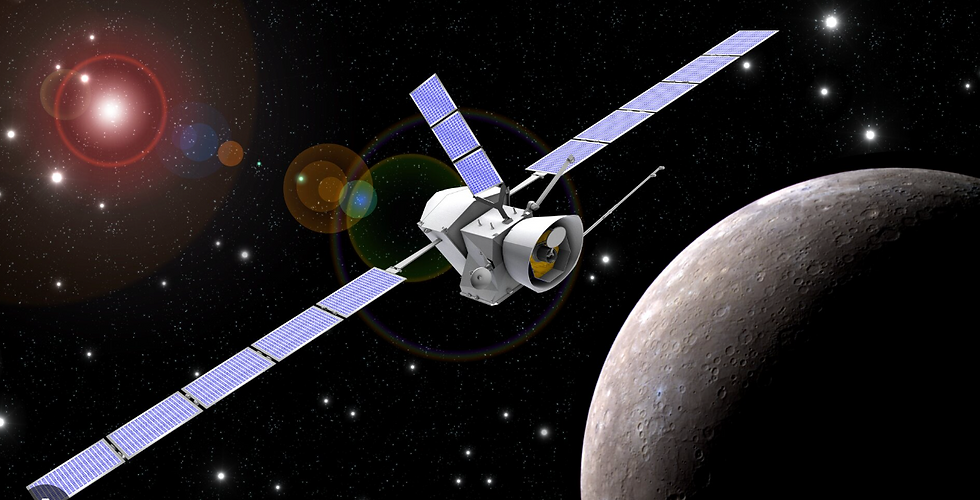The Lobanov-Rotovsky lecture is annually hosted by the Oxford Department of Earth Sciences in the Oxford University Museum of Natural History. This year it was presented by Professor Emma Bunce from the University of Leicester. Bunce is head of the School of Physics and Astronomy at Leicester as well as being President of the Royal Astronomical Society. The lecture was focused on two interplanetary missions that she was involved in: the BepiColombo mission to Mercury and the JUICE mission to Jupiter.

Image from: https://www.esa.int/Enabling_Support/Space_Engineering_Technology/Hot_stuff_the_making_of_BepiColombo
As I am still only a second year undergrad it is safe to say that there were elements of the lecture that went right over my head. However, it was a public lecture and pitched to an audience without much assumed scientific knowledge so I understood the vast majority and it was an incredibly interesting talk. Although my usual attendance at departmental seminars and other non-compulsory lectures tends to be somewhat lacking during term time, I recommend trying to go to them wherever possible. It is so interesting to learn about aspects of your field that aren't in the taught course and I am very pleased I went to this one.
The lecture started off by discussing the robotics involved in the JUICE mission to Jupiter. JUICE stands for JUpiter ICy moons Explorer and this mission basically involved looking for evidence of deep oceans on Jupiter's icy moons as part of a search for habitable worlds. Deep oceans means liquid water which means potential life, there are nine ocean worlds that have been identified in Jupiter's system (Jupiter and its moons) and the talk mostly focused on three of Jupiter's moons - Io, Europa and Ganymede. These three bodies orbit Jupiter in an elliptical rather than a circular pattern which causes an orbital resonance (their gravities pull on each other) driving a solid tide. The solid tide basically means that the bodies squeeze a bit to bulge more in different directions: click here if you want to find out more. This tidal flexing is thought to maybe heat the interior of the moons and cause a liquid ocean to exist beneath an ice crust.

Photo taken before the lecture began, in the lecture theatre at the Oxford University Museum of Natural History.
The JUICE mission aims to expand on information found out about the Jupiter system during the Voyager missions in the 1970s. While Voyager did a flyby of Jupiter and Io, JUICE plans to focus on Ganymede and look at its internal magnetic field in order to detect an ocean. A salty ocean (rather than pure water) would be needed to explain certain magnetic field patterns. The JUICE mission was launched in April 2023 and will take eight years to reach the Jupiter system. Bunce discussed the robotic and scientific instruments deployed on the mission including the JUICE magnetometer, a UK built instrument on the JUICE mission, lead by a team at Imperial College London which Bunce herself was involved in.
The second part of the lecture then focused on the BepiColombo mission to Mercury planned for 2026-2028. Missions to Mercury face the problem that any scientific instruments aboard them need to be able to withstand the intense heat and radiation associated with Mercury being our solar system's closest planet to the sun. It's also very hard to get into orbit around Mercury due to the proximity to the Sun's magnetic field. BepiColombo consists of two different spacecraft, one that will orbit Mercury nearer the planet and one that will orbit in deeper space. This means that the two different craft can have specialised scientific payloads (things they're carrying) to conduct different experiments and take readings with the aim of better understanding the geochemistry of Mercury. Some of the instruments to do this that will be going up on the BepiColombo missions are currently being built at the University of Leicester.
Overall, Bunce's lecture focused on the different instruments being used to carryout breakthrough science in space and help us learn about other planetary bodies within our solar system. The shear length of time space missions take (eight years to even reach Jupiter and four more to do the science) really made me realise how much passion the people working on these projects must have and how frustrating it must be to spend a chunk of your career developing instruments for a mission that may only start to collect data once you have retired. One audience member asked a question that really put this into perspective: "How does it feel that the PhD students that will be analysing the data from the JUICE mission are currently in Year 7?". A bit of a crazy thought to think about but just goes to show how there is so much future in space exploration and we are really only just at the start of further deep space exploration.
Lobanov-Rotovsky Lecture 2023: https://www.earth.ox.ac.uk/events/lobanov-rostovsky-lecture-2023-robotic-exploration-of-our-solar-system/
JUICE mission (ESA): https://www.esa.int/Science_Exploration/Space_Science/Juice
BepiColombo Mission (ESA): https://www.esa.int/Science_Exploration/Space_Science/BepiColombo
Comentarios